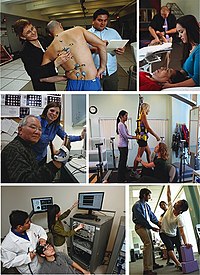
Photo from wikipedia
Advances in brain–computer interface (BCI) technology have facilitated the detection of Motor Imagery (MI) from electroencephalography (EEG). First, we present three strategies of using BCI to detect MI from EEG:… Click to show full abstract
Advances in brain–computer interface (BCI) technology have facilitated the detection of Motor Imagery (MI) from electroencephalography (EEG). First, we present three strategies of using BCI to detect MI from EEG: operant conditioning that employed a fixed model, machine learning that employed a subject-specific model computed from calibration, and adaptive strategy that continuously compute the subject-specific model. Second, we review prevailing works that employed the operant conditioning and machine learning strategies. Third, we present our past work on six stroke patients who underwent a BCI rehabilitation clinical trial with averaged accuracies of 79.8% during calibration and 69.5% across 18 online feedback sessions. Finally, we perform an offline study in this paper on our work employing the adaptive strategy. The results yielded significant improvements of 12% (p < 0.001) and 9% (p < 0.001) using all the data and using limited preceding data respectively in the feedback accuracies. The results showed an increase in the amount of training data yielded improvements. Nevertheless, results of using limited preceding data showed a larger part of the improvement was due to the adaptive strategy and changing subject-specific models did not deteriorate the accuracies. Hence the adaptive strategy is effective in addressing the non-stationarity between calibration and feedback sessions.
Journal Title: IEEE Transactions on Neural Systems and Rehabilitation Engineering
Year Published: 2017
Link to full text (if available)
Share on Social Media: Sign Up to like & get
recommendations!